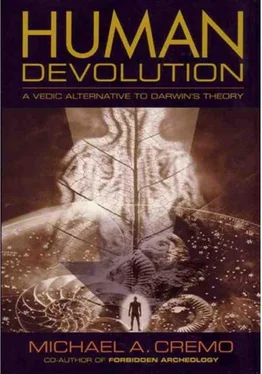Michael Cremo - Human Devolution - A Vedic Alternative To Darwin's Theory
Здесь есть возможность читать онлайн «Michael Cremo - Human Devolution - A Vedic Alternative To Darwin's Theory» весь текст электронной книги совершенно бесплатно (целиком полную версию без сокращений). В некоторых случаях можно слушать аудио, скачать через торрент в формате fb2 и присутствует краткое содержание. Год выпуска: 2003, ISBN: 2003, Издательство: Torchlight Publishing, Жанр: Старинная литература, на английском языке. Описание произведения, (предисловие) а так же отзывы посетителей доступны на портале библиотеки ЛибКат.
- Название:Human Devolution: A Vedic Alternative To Darwin's Theory
- Автор:
- Издательство:Torchlight Publishing
- Жанр:
- Год:2003
- ISBN:9780892133345
- Рейтинг книги:4 / 5. Голосов: 1
-
Избранное:Добавить в избранное
- Отзывы:
-
Ваша оценка:
- 80
- 1
- 2
- 3
- 4
- 5
Human Devolution: A Vedic Alternative To Darwin's Theory: краткое содержание, описание и аннотация
Предлагаем к чтению аннотацию, описание, краткое содержание или предисловие (зависит от того, что написал сам автор книги «Human Devolution: A Vedic Alternative To Darwin's Theory»). Если вы не нашли необходимую информацию о книге — напишите в комментариях, мы постараемся отыскать её.
Human Devolution: A Vedic Alternative To Darwin's Theory — читать онлайн бесплатно полную книгу (весь текст) целиком
Ниже представлен текст книги, разбитый по страницам. Система сохранения места последней прочитанной страницы, позволяет с удобством читать онлайн бесплатно книгу «Human Devolution: A Vedic Alternative To Darwin's Theory», без необходимости каждый раз заново искать на чём Вы остановились. Поставьте закладку, и сможете в любой момент перейти на страницу, на которой закончили чтение.
Интервал:
Закладка:
Stokes did not attend, but raised some questions about the previous experimental set up. crookes replied, “It would have required a force of 74.5 lb.to have been exerted by Mr. Home to have produced the results, even if all your suppositions are granted; and, considering that he was sitting in a low, easy chair, and four pairs of sharp, suspicious eyes were watching to see that he exerted no force at all, but kept the tips of his fingers lightly on the instrument, it is sufficiently evident that an exertion of this pressure was impossible” (crookes 1871b, in Medhurst and Goldney 1972, p. 45). Stokes suggested some of the results were caused by vibrations of vehicles passing by on the street. crookes answered: “The upward and downward motion of the board and index was of a very slow and delicate character, occupying several seconds for each rise and fall; a tremor produced by passing vehicles is a very different thing from a steady vertical pull of from 4 to 8 lb., lasting for several seconds” (crookes 1871b; in Medhurst and Goldney 1972, p. 46). In his letter to Stokes, crookes added: “So many scientific men are now examining these strange phenomena (including many fellows of the Society), that it cannot be many years before the subject will be brought before the scientific world in a way that will enforce attention” (crookes 1871b; in Medhurst and Goldney 1972, p. 46). Home had the ability to make an accordion play tunes while holding it by one hand, on the end opposite the keys. The immediate skeptical doubt is that he was using a trick accordion. To guard against this, crookes purchased a new accordion, never seen or handled by Home. Another possibility was that Home was somehow using a free hand to manipulate the instrument. To guard against this, crookes built a special cage, which was placed beneath a table. The accordion was placed inside the cage, and Home was asked to insert one hand into the cage and grasp the end of the accordion opposite the end with the keys. Under these circumstances, the accordion played as usual. crookes (1871a) then observed: “The accordion was now again taken without any visible touch from Mr. Home’s hand, which he removed from it entirely and placed upon the table, where it was taken by the person next to him, and seen, as now were both his hands, by all present. I and two of the others present saw the accordion distinctly floating about inside the cage with no visible support. This was repeated a second time, after a short interval. Mr. Home presently re-inserted his hand in the cage and again took hold of the accordion. It then commenced to play, at first, chords and runs, and afterwards a well-known sweet and plaintive melody, which it executed perfectly in a very beautiful manner. Whilst this tune was being played, I grasped Mr. Home’s arm, below the elbow, and gently slid my hand down it until I touched the top of the accordion. He was not moving a muscle. His other hand was on the table, visible to all, and his feet were under the feet of those next to him” (Medhurst and Goldney 1972, p. 27).
At a sitting with Home, crookes observed writing produced in a mysterious fashion. The sitting took place in the light, at the home of crookes, and in the presence of friends. crookes asked for a written message. Here is his description of what happened: “A pencil and some pieces of paper were lying on the centre of the table; presently the pencil rose on its point, and after advancing by hesitating jerks to the paper, fell down. It then rose and fell again. A third time it tried, but with no better result. After this a small wooden lath, which was lying upon the table, slid toward the pencil, and rose a few inches from the table; the pencil rose again, and propping itself against the lath, the two together made an effort to mark the paper. It fell and then a joint effort was again made. After a third trial, the lath gave it up and moved back to its place, the pencil lay as it fell across the paper, and an alphabetic message told us ‘We have tried to do as you asked, but our power is exhausted”’ (crookes 1874, p. 93).
crookes supplied these notes of another séance with Home, on May 22, 1871, attended by himself and Wallace: “The table now rose completely off the ground several times whilst the gentlemen present took a candle, and kneeling down deliberately examined the position of Mr. Home’s feet and knees, and saw the three feet of the table quite off the ground. This was repeated, until each observer expressed himself satisfied that the levitation was not produced by mechanical means on the part of the medium or any one else present” (crookes 1889; in Gauld 1968, p. 214).
Home could not only levitate objects. He himself would often float into the air. crookes witnessed this three times and was aware of an additional one hundred recorded reports of Home’s levitations. About the Home levitation events he witnessed in his own home, crookes said: “He went to a clear part of the room, and, after standing quietly for a minute, told us he was rising. I saw him slowly rise up with a continuous gliding movement and remain about six inches off the ground for several seconds, when he slowly descended. On this occasion no one moved from their places. On another occasion I was invited to come to him, when he rose 18 inches off the ground, and I passed my hands under his feet, round him, and over his head, when he was in the air. . . . On several occasions Home and the chair on which he was sitting at the table rose off the ground. This was generally done very deliberately, and Home sometimes then tucked up his feet on the seat of the chair and held up his hands in full view of us. On such an occasion I have got down and seen and felt that all four legs were off the ground at the same time, Home’s feet being on the chair. Less frequently the levitating power extended to those sitting next to him. Once my wife was thus raised off the ground in her chair” (carrington 1931, p. 158).
The very credible reports of levitations by Home lend credence to the reports of earlier levitations reports involving catholic saints. for example, several persons observed levitations by St. francis of Assisi (c. 1181–1226). Around the year 1261, St. Bonaventure wrote that the radiant St. francis was sometimes seen lifted off the ground during prayer (Thurston 1952, p. 6). In the little Flowers of St. Francis, we learn that Brother Leo, a member of the franciscan order, several times saw St. francis “rapt in God and uplifted from the ground sometimes for the space of three cubits, sometimes of four, and sometimes even to the height of the beech-tree” (Thurston 1952, p. 5). A cubit corresponds to roughly 18 inches.
William James (Psychologist)
William James (1842–1910), one of the founders of modern psychology, was an active member of the American and English branches of the Society for Psychical Research, serving a term as the English SPR’s president (1894–1896). Many other key figures in the history of psychology participated in the activities of the SPR. freud and Jung published articles in its journal and proceedings (Gauld 1968, pp. 338–339). James had a very high opinion of the scientific quality of the publications of the SPR. He said, “Were I asked to point to a scientific journal where hardheadedness and never-sleeping suspicion of sources of error might be seen in their full bloom, I think I should have to fall back on the Proceedings of the Society for Psychical Research. The common run of papers, say on physiological subjects, which one finds in other professional organs, are apt to show a far lower level of critical consciousness” (James 1897; in Murphy and Ballou 1960, p. 29).
James’s first major investigation into psychic phenomena involved the medium Mrs. Leonora f. Piper. She could provide information about her visitors through a spirit being named Phinuit, who spoke through her when she was in trance. Skeptics proposed she got the information from good detective work or by extracting the information from her visitors by expert psychological methods. After learning of Mrs. Piper through his mother-in-law, James went to her and began a series of experiments. during the years 1885 and 1886, James sent to Mrs. Piper twenty-five people unknown to her, under pseudonyms. finding that Mrs. Piper was able to give information about the persons that should not have been known to her, James became convinced of the genuineness of her mediumship (Gauld 1968, pp. 251–253).
Читать дальшеИнтервал:
Закладка:
Похожие книги на «Human Devolution: A Vedic Alternative To Darwin's Theory»
Представляем Вашему вниманию похожие книги на «Human Devolution: A Vedic Alternative To Darwin's Theory» списком для выбора. Мы отобрали схожую по названию и смыслу литературу в надежде предоставить читателям больше вариантов отыскать новые, интересные, ещё непрочитанные произведения.
Обсуждение, отзывы о книге «Human Devolution: A Vedic Alternative To Darwin's Theory» и просто собственные мнения читателей. Оставьте ваши комментарии, напишите, что Вы думаете о произведении, его смысле или главных героях. Укажите что конкретно понравилось, а что нет, и почему Вы так считаете.












